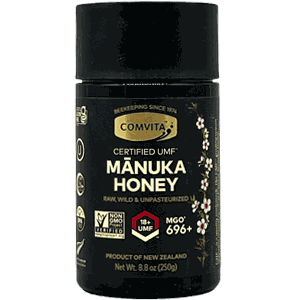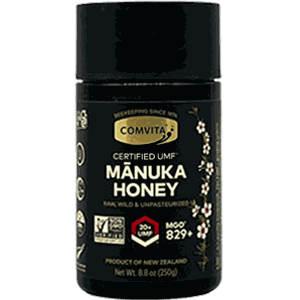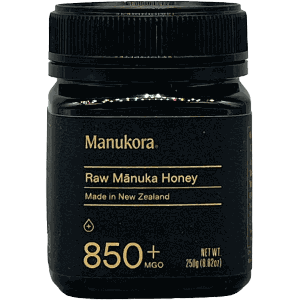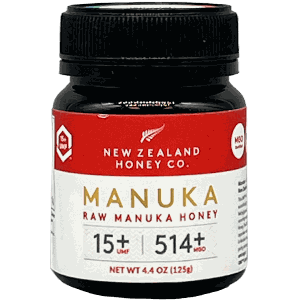Summary
What is Manuka Honey?
Manuka honey is a type of honey produced by bees that feed on the nectar of flowers of the manuka bush (Leptospermum scoparium), which is native to New Zealand. This makes it relatively rare, harder to find, and much more expensive than other honeys. In fact, manuka honey costs 6 to 25 times more than other types of honey (Hegazi, J Food Sci Technol 2021). Manuka honey contains a compound called methylglyoxal (MGO), which may give it its unique health benefits compared to other honey types (Kazmierczak-Baranska, Curr. Issues Mol. Biol 2024).
The most common system used to grade manuka honey is the UMF (Unique Manuka Factor), which assesses manuka honey using markers including methylglyoxal (MGO) for potency, leptosperin for authenticity, hydroxymethylfurfural (HMF) for freshness, and dihydroxyacetone (DHA) for remaining shelf life (see What It Is).
What are the health benefits of manuka honey?
Clinical research on the health benefits of manuka honey is limited, but some evidence suggests that manuka honey has antibacterial and possible wound-healing effects. It may also soothe symptoms of cough and sore throat and benefit those with gastrointestinal disorders, such as gastroesophageal reflux disease (GERD). Although research is inconclusive, it may have topical applications in treating eyelid infections and dry eye(see What It Does).

What did ConsumerLab’s tests of manuka honey show?
We found the eight tested manuka honeys to differ significantly in potency. This was measured as the concentration of methylglyoxal (or MGO) in the honey, which ranged from just 96 to as much as 1,113 mg/kg. In fact, MGO was so low in one product that it would be categorized as having a UMF of only 5+, while the other products would qualify for a UMF of 10 to 25+. Due to these differences, the cost to get a significant dose of MGO (20 mg -- about the amount in a tablespoon of high-quality manuka honey) ranged more than 3-fold, from under $5 to more than $16.
Products also differed significantly in freshness, as measured by levels of hydroxymethylfurfural (HMF). The manuka honey in two products would not meet the UMF freshness standard expected of manuka honey, likely due to some loss of freshness during their time on shelves.
The good news was that most products met the specifications required of their labeled UMF rating and MGO levels (and several exceeded them), and none were contaminated with heavy metals such as lead (see What CL Found, our Results table comparing products on all dimensions, and How Products Were Evaluated).
Which manuka honey is best?
Based on ConsumerLab's laboratory and taste tests, two products were selected as Top Picks for manuka honey. These provide exceptional quality, freshness, taste and value at two different levels of potency.
Is manuka honey safe to use?
Manuka honey is generally considered safe to use. However, when consumed in large amounts (between 50 and 100 g), it may have laxative effects. Manuka honey may not be safe to use on certain wounds, such as severe burns and wounds in people with diabetes. Manuka honey is high in sugar and can impact blood sugar and blood lipid levels when consumed in large amounts. Immunosuppressed people, such as those undergoing cancer treatment, should avoid raw honey, as such people are more susceptible to infections that may be caused by microbes in raw honey. Honey should not be given to babies younger than 12 months due to the risk of botulism (see Concerns and Cautions).














